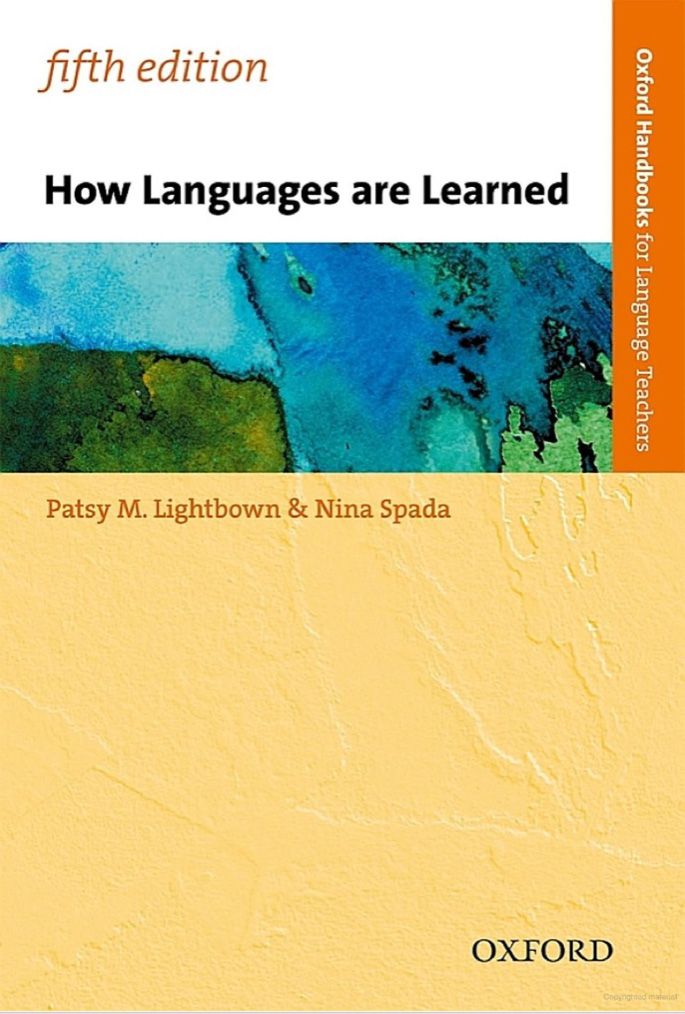 How Languages Are Learned
How Languages Are Learned
5th Edition
by Patsy M. Lightbown & Nina Spada
Oxford University Press, 2021
ISBN 9780194406291
$62.95, 296 pp
oupcanada.com
Every classroom across Canada is unique. Within each learning environment, multiple cultures are represented by diverse learners who all bring with them their own talents and abilities. As teachers, we have much to consider when planning our instruction for these learners. How and what will we teach? Can we meet the needs of all our students? How will we know we’ve been successful? Patsy Lightbown and Nina Spada have been working for over forty years to help teachers consider and reconsider these questions. This latest edition of How Languages are Learned is an informed resource for anyone who works with children and young adults learning a second language.
Lightbown and Spada have spent their careers in second language research and education. Lightbown is currently a Professor Emerita of Applied Linguistics at Concordia University in Montreal and Nina Spada is a Professor Emerita at the Ontario Institute for Studies in Education, University of Toronto. Together, they have created this resource to help educators consider both theory and research when planning instruction. This edition is helpful, not only to those who specifically teach second language acquisition, but also to classroom teachers who are ready to reflect upon their own practice which includes students learning a second language.
This resource is organized into seven chapters that work together to scaffold information about both first (L1) and second (L2) language acquisition theories, methods for observation and analysis of teaching, and specific methods for teaching students a second language. The authors begin by having readers consider and reflect upon how children learn their first language. They consider three theories (behaviourist, innatist, and developmental perspectives) of language acquisition, providing research-based examples for each. These theories and examples provide readers with a reminder of what we know about first language acquisition, grounding us in the context of language development, before considering how a second language is learned. The authors compare L2 acquisition theories to those of L1, while also considering the relevance of individual learning characteristics such as motivation, age, and personality on overall L2 success.
This resource also aims to enlighten readers on research methods that can be used to describe and interpret teaching activities and learning environments. The authors provide both qualitative and quantitative method examples, such as observational checklists (quantitative) based on predetermined outcomes and ethnographic approaches which are open-ended and broader in scope (qualitative). Each method is described with specific classroom examples,
making them both relatable and relevant to those who work with students learning a second language. Additionally, the authors encourage teachers to engage in their own action research, in order to investigate inquiries based on their specific situations. Although examples of action research studies are not included, each chapter ends with suggestions for further reading which guide those interested to additional resources.
In addition to L2 research and theory, Lightbown and Spada provide six proposals for L2 teaching with research-based examples from classroom settings. These proposals call into question instructional focus which is placed on specifics such as grammar, content, meaning, and conversation. The authors explore each proposal by providing examples of both benefits and shortcomings within each practice. The research examples are from multiple classroom settings including French immersion classrooms, intensive ESL classes and foreign/immigrant students learning L2 in classroom settings where most speak the majority language (English).
What perhaps makes this resource most practical for readers is the variety of extras and interactive activities provided throughout. For example, the introduction includes an opinion activity that engages readers in reflection upon their own beliefs surrounding second language acquisition. The resource concludes with a final chapter returning to these exact questions, providing answers, based on the content of the resource, to explain each. This provides both clarity and reflection upon each reader’s new knowledge and understanding gained regarding L2 teaching. Each chapter includes similar activities, reflection questions and additional resources for further reading. An extensive glossary of terms provides clarification for both novice and experienced teachers. Lastly, a companion website offers printable additions to each chapter activity which could be used by individual educators or in a larger professional development setting.
We live in a diverse country with multiple cultures and languages represented within our communities and schools. This resource introduces readers to language acquisition research and theories with the goal of both reflection and inspiration upon materials and methods for teaching ESL students. Using research from multiple classroom settings, the authors provide readers with practical advice and suggestions for beginning or extending their own journeys within second language learning, teaching and research.
Review by Melissa McKinney-Lepp.
This review is featured in Canadian Teacher Magazine’s Spring 2022 issue.









